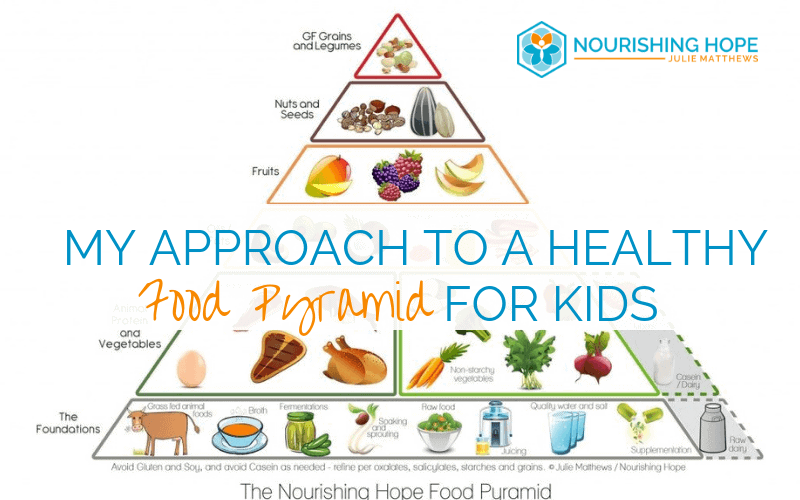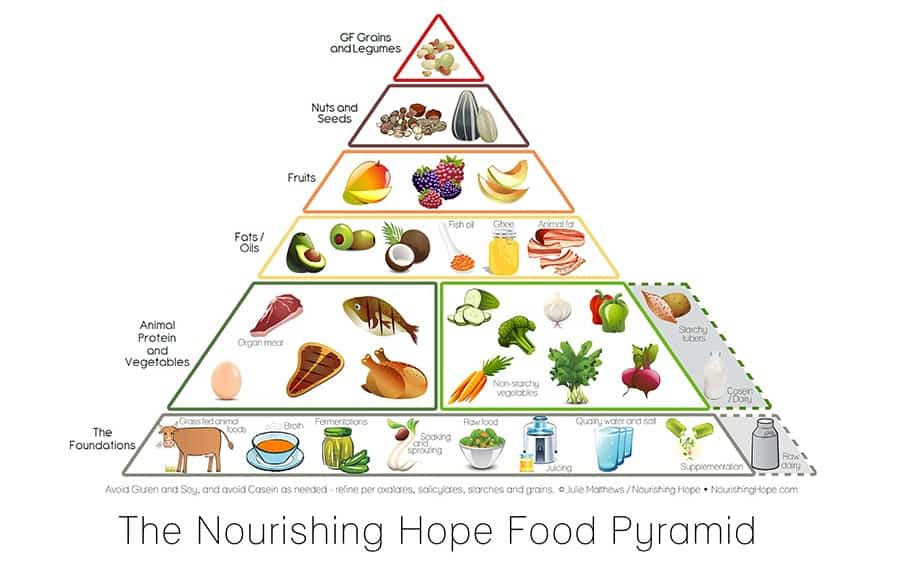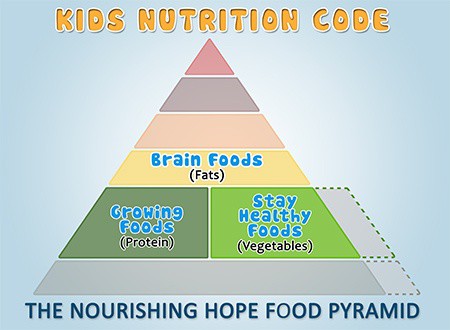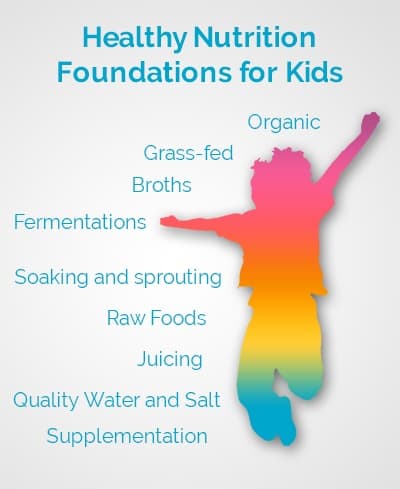
It’s no secret that we live in a culture of fad diets and nutritional trends. In fact, the odds are that you’ve heard of several new ones this year alone. Mediterranean, keto, vegan, and more– with all these options, what’s the best choice for eating healthy?
Especially as a parent, it can feel perplexing and overwhelming to understand what’s best for your child’s nutritional needs.
American dietary guidelines for children have changed over the past century; the most current standard is MyPlate. This newest iteration is an attempt by government to combat the wave of childhood obesity sweeping our nation.
While this protocol for kids is widely followed in the school systems, as a Certified Nutrition Consultant and Educator, and Mother, I know we can do better for our little ones. In this article, I will introduce to you a modern and healthy food pyramid for kids and I’ll explain how eating this way can improve their learning and behavior far beyond MyPlate.
Should you Choose the USDA’s MyPlate?
MyPlate is a fairly simple approach to children’s nutrition that aims to encourage kids to eat healthy.
Their basic premise is to fill half your child’s plate with fruits and vegetables, avoid sugary beverages like fruit juices, and opt for more whole grains. It also urges children to have a glass of low-fat dairy (like a cup of milk) with each meal and to engage in regular physical activity.
While this may be a starting point for those struggling to move past obesity, there are better ways to fuel the body long-term, and to provide the nutrition children need.
The MyPlate model doesn’t account for inflammatory foods that can aggravate issues like autism, ADHD, anxiety, and gastrointestinal problems. It also doesn’t consider common food allergens like wheat and dairy products, and there’s no mention of how to add good oils and healthy fats into your child’s diet.
Regarding the “fill half your plate with fruits and vegetables” suggestion, almost half is reserved for fruit. That means the vegetable portion is merely a quarter of the plate, which may not allow for the levels of vegetables kids should really be eating.
Because vegetables have incredible properties including decreasing cancer risk, improving behavioral symptoms in ADHD, I’d like to see more description of the diverse types of veggies available in their veggie category.
And MyPlate makes no mention of the advantages of choosing organic. Pesticides in non-organic foods are the primary way children become exposed to these damaging neurotoxins. One recent study showed that children eating conventional produce had 6 times the level of pesticides in their bodies than those on an organic diet. To be most protective of children’s health, I’d like to see them recommend eating an organic diet, that includes high quality grass-fed meat as well.
While MyPlate is better than the outdated USDA kids MyPyramid, I and many other nutritionists today believe that many improvements still need to be made.
The food our children eat is either nourishing or negatively impacting their daily lives. As a nutritionist and parent today, I believe we should be asking the question, “What are the best tolerated, easiest to digest, and most nutrient-rich foods my child can eat?”
My Approach to Food Groups
As a parent myself, I know you want to make the most of any time you spend in the kitchen. I believe that a food pyramid for kids should include a variety of foods and be based on scientific research and cutting-edge ideas.
That’s why the foundations of my pyramid include not only basic food groups, but more categories of natural foods and supplements. Through my thousands of hours of research, analysis, and clinical experience in the field of nutrition, here are the groups that I’ve found to be most healthful.
The Department of Agriculture’s “MyPlate” as five food groups, of which two are dairy and gluten-containing foods (under “Grains)”. My food pyramid for kids has seven. That’s because I know that the diversity of a child’s diet has a major impact on their health down the line. The groups include:
- Vegetables
- Animal protein
- Good fats
- Fruits
- Nuts/seeds
- Legumes and gluten-free grains
- Nutrition foundations: organic, grass-fed… (described below)

Research shows that diet and learning are interconnected.
When we feed our children grass-fed, organic, non-inflammatory foods, we are setting them up for success in the classroom as well. Not only that, but better nutrition leads to better behavior, especially in cases of ADHD or autism. When we approach food groups with the idea that “food is medicine,” we can see major benefits for our children.
 I find that, in my approach to food groups, allowing your child to understand healthy eating habits for themselves is a huge win. With children, I call protein “growing food,” vegetables “stay healthy foods,” and good fats “brain foods.”
I find that, in my approach to food groups, allowing your child to understand healthy eating habits for themselves is a huge win. With children, I call protein “growing food,” vegetables “stay healthy foods,” and good fats “brain foods.”
When we can teach children what they need in terms they grasp, a kids food pyramid can prepare them for empowered, informed eating decisions into the teenage years and beyond.
The greatest challenge when implementing a varied diet is often patience. I frequently hear parents say that their child simply won’t eat the healthy food choices. But with a little planning and support using my guide on navigating meals with a picky eater, you can make progress and see lasting success.
The Nourishing Hope Food Pyramid for Kids
I believe that food isn’t just healthy… it’s healing. I created my own Nourishing Hope Food Pyramid to support parents in learning how to actualize this mindset. And it’s incorporated in my online nutrition program for parents, Nourishing Hope for Healing Kids.
This food pyramid values food for its nourishment and role as healing “medicine.” I begin with nutrition foundations that make foods more nutritious.
Nutrition Foundations
 These foundations at the base of the pyramid include concepts that make foods more nutrient dense and easily digested, such as: fermenting, sprouting, juicing, raw foods, bone broth, quality water and salt, supplementation, and more. Additional principles include organic and grass-fed foods. These aren’t included on a broader guideline like MyPlate, but are incredibly effective in getting your child the nutrition they need to thrive.
These foundations at the base of the pyramid include concepts that make foods more nutrient dense and easily digested, such as: fermenting, sprouting, juicing, raw foods, bone broth, quality water and salt, supplementation, and more. Additional principles include organic and grass-fed foods. These aren’t included on a broader guideline like MyPlate, but are incredibly effective in getting your child the nutrition they need to thrive.
Beyond the nutrients found in my food pyramid for kids, I’ve also filtered the foods by what they don’t contain. Some compounds found in “healthy” foods can be inflammatory — like gluten, lectins, salicylates, and oxalates. Just because something is a whole food doesn’t mean you should load up on it. The best way for health and healing is to eat a variety of nutrient dense foods for children’s growing needs, and to know what’s in your food.
It’s important to note that my Nourishing Hope Food Pyramid is not a fad diet. This is a way of eating that will boost your child’s quality of life, whether they need foods to combat ADHD symptoms, won’t put down the junk food, or refuse to try lentils. With the right basics, a properly proportioned food guide pyramid, and appropriate supplementation, your kids’ health can flourish like never before.
5 Principles of Healthy Eating
I’m a mother, a Certified Nutrition Consultant, and specialist in autism and ADHD. Therefore, I can look at a food guide from many different angles. Here are five principles of healthy eating I believe are important for a healthy child
1. Vegetables Go With Everything
Veggies for breakfast, lunch, or dinner? The answer is always, “Yes!”
I recommend organic veggies with every single meal. Don’t just stick with broccoli — healthy kids benefit from eating a variety of colors and types of vegetables. In my approach, I share how many vegetables belong in breakfast, lunch, and dinner, along with some meal ideas (and recipes!) to incorporate them.
I know that hitting a goal of six total vegetables each day sounds intimidating to some. Unfortunately, most children in the U.S. get far below the daily recommended amount.
This is why I created my V123TM method, part of my Nourishing Hope for Healing Kids program. I find that once you begin to intentionally add in vegetables and keep them on hand, it becomes increasingly natural to incorporate them into each meal.
The Nourishing Hope V123TM method stands for Veggies 1, 2, 3. One vegetable at breakfast, two vegetables at lunch, and three vegetables at dinner. By eating vegetables throughout the day you can easily get six vegetables – or MORE – in each day. In fact, I love to add a vegetable with snack and a vegetable in a smoothie, for 7 or 8 vegetables everyday.
2. All Children with Special Needs Can Benefit from a Specialized Diet
It’s no secret that diet can play a major role in reducing symptoms and improving life for children with autism and special needs. More and more research indicates that our gut (and it’s diverse microbiome) is our “second brain.”
Physiological symptoms can stem from what’s happening in our digestive system, and symptoms of ADHD and autism are no exception. This phenomenon has prompted me to study the creation of customized diets since the early days of my career.
3. Go Gluten-Free, Casein-Free, and Soy-Free
If your child struggles with gastrointestinal issues, ADHD, or autism, I highly recommend considering a gluten-free, casein-free, and soy-free diet. Studies show that removing gluten and casein (proteins found in wheat, wheat derivatives, and dairy) can improve symptoms of ADHD and autism. Furthermore, children with allergies are less likely to get proper nutrition, so ensuring a healthy gluten-free, casein-free and soy-free diet is a must.
Grains, and particularly gluten, can be most irritating to the digestive system. In my program, I leave out gluten-containing grains altogether and only recommend casein when it’s tolerated. They can cause gas, bloating, and inflammation in the digestive system.
When following my program you may be alerted of food sensitivities you didn’t recognize in your child before, and then can lower inflammation and improve digestion by making strategic adjustments to diet.
4. Every Child Is Different
While all families can benefit from the aforementioned healthy tips, the biochemical makeup and needs of each child are different.
And this makes sense… Every child is unique and every child has unique nutritional needs.
You may find your little one needs some extra protein, or less grain than you expected, as well as individually tailored supplements. Nourishing hope is about discerning and applying the most supportive food and nutrition plan for each individual child.
5. Parents Need Nourishing, Too
It takes time and energy to care for your child, especially when altering their diet to get them the nutrition they need.
I encourage you to extend that same care to yourself– to spend time doing things that are good for and nourish you!
Don’t forget to feed yourself the same healthy things, spend time appreciating what you find beautiful, and get out in nature. When we reach burnout, our eating can be the first habit to go, so don’t neglect yourself. For more ideas, check out my guide to self-care for parents.
In Summary
- While the USDA’S MyPlate is well-meaning, it doesn’t begin to cover the complexity of what a child needs for optimal healing and health.
- Nutrition foundations, like organic produce, grass-fed meat, broth, and fermented foods are crucial for children’s development.
- By adding in these foundations, increasing vegetable intake, and avoiding food allergens/sensitivities, your child can actually heal through food.
- My signature program, which includes these Nourishing Hope Food Pyramid principles, will boost your child’s nutrition and help them begin to heal, improving their behavior and learning.
- Remember that your child is an individual, incorporate individualized nutrition into their healthcare plan, and take the time to care for yourself.
- Follow my program and food pyramid for kids and prepare to be amazed by the results in the classroom, home, and behavior over time.
Sources
- Fakhouri, T. H., Ogden, C. L., Carroll, M. D., Kit, B. K., & Flegal, K. M. (2012). Prevalence of obesity among older adults in the United States, 2007-2010 (Vol. 106, pp. 1-8). US Department of Health and Human Services, Centers for Disease Control and Prevention, National Center for Health Statistics. Abstract: https://www.ncbi.nlm.nih.gov/pubmed/22617494
- Fernandez, E., D’Avanzo, B., Negri, E., Franceschi, S., & La Vecchia, C. (1996). Diet diversity and the risk of colorectal cancer in northern Italy. Cancer Epidemiology and Prevention Biomarkers, 5(6), 433-436. Abstract: https://www.ncbi.nlm.nih.gov/pubmed/8781738
- Howard, A. L., Robinson, M., Smith, G. J., Ambrosini, G. L., Piek, J. P., & Oddy, W. H. (2011). ADHD is associated with a “Western” dietary pattern in adolescents. Journal of attention disorders, 15(5), 403-411. https://www.ncbi.nlm.nih.gov/pubmed/20631199
- Curl, C. L., Fenske, R. A., & Elgethun, K. (2003). Organophosphorus pesticide exposure of urban and suburban preschool children with organic and conventional diets. Environmental health perspectives, 111(3), 377-382. https://ehp.niehs.nih.gov/doi/abs/10.1289/ehp.5754
- de Wild, V. W., de Graaf, C., Boshuizen, H. C., & Jager, G. (2015). Influence of choice on vegetable intake in children: an in-home study. Appetite, 91, 1-6. Abstract: https://pubag.nal.usda.gov/catalog/5356012
- Bellisle, F. (2004). Effects of diet on behaviour and cognition in children. British Journal of nutrition, 92(S2), S227-S232. Abstract: https://www.cambridge.org/core/journals/british-journal-of-nutrition/article/effects-of-diet-on-behaviour-and-cognition-in-children/54F8DA9C708A34A737D663BBEABED1D0
- Donev, R., & Thome, J. (2010). Inflammation: good or bad for ADHD?. ADHD Attention Deficit and Hyperactivity Disorders, 2(4), 257-266. Abstract: https://www.ncbi.nlm.nih.gov/pubmed/21432611
- Pelsser, L. M., Frankena, K., Toorman, J., Savelkoul, H. F., Dubois, A. E., Pereira, R. R., … & Buitelaar, J. K. (2011). Effects of a restricted elimination diet on the behaviour of children with attention-deficit hyperactivity disorder (INCA study): a randomised controlled trial. The Lancet, 377(9764), 494-503. https://www.sciencedirect.com/science/article/pii/S0140673610622271
- Jyonouchi, H., Geng, L., Ruby, A., Reddy, C., & Zimmerman-Bier, B. (2005). Evaluation of an association between gastrointestinal symptoms and cytokine production against common dietary proteins in children with autism spectrum disorders. The Journal of pediatrics, 146(5), 605-610. Abstract: https://www.ncbi.nlm.nih.gov/pubmed/15870662
- Knivsberg, A. M., Reichelt, K. L., & Nødland, M. (2001). Reports on dietary intervention in autistic disorders. Nutritional Neuroscience, 4(1), 25-37. Abstract: https://www.ncbi.nlm.nih.gov/pubmed/11842874
- Whiteley, P., Haracopos, D., Knivsberg, A. M., Reichelt, K. L., Parlar, S., Jacobsen, J., … & Shattock, P. (2010). The ScanBrit randomised, controlled, single-blind study of a gluten-and casein-free dietary intervention for children with autism spectrum disorders. Nutritional neuroscience, 13(2), 87-100. Abstract: https://www.ncbi.nlm.nih.gov/pubmed/20406576
- Ridaura, V., & Belkaid, Y. (2015). Gut microbiota: the link to your second brain. Cell, 161(2), 193-194. Abstract: https://www.ncbi.nlm.nih.gov/pubmed/25860600




0 Comments